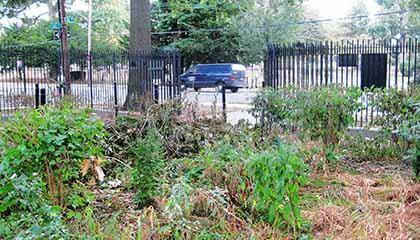By Connor Adams Sheets
It’s the middle of August and the grass has turned brown in many of Flushing’s outdoor spaces from Kissena Park to Flushing Cemetery.
But the grass and foliage at the Olde Towne of Flushing Burial Ground, known until December 2009 as Martins Field, is in particular disrepair.
On Monday evening, piles of rotting, pungent vegetation greeted visitors just inside the ground’s gates, grass and shrubs were sunburned and dead, caution tape encircled most trees. Trash was strewn across a plaque honoring the 500 to 1,000 blacks and American Indians buried there in the 19th century after dying of small pox and cholera.
That state of disrepair does not sit well with Mandingo Tshaka, the Bayside community activist who was instrumental in getting the site renamed to reflect the honor of the people who were buried under what is now a city park. He is looking to encourage the city to take better care of the site.
“The Parks Department totally eradicated the history of my people and disregarded them and you’ll see it right out here in Flushing,” he said. “It’s time that this city stand up and do the right thing: Respect this cemetery.”
Located between 164th and 165th streets along 46th Avenue in Flushing, the renaming of the site was a result of a longtime effort led by Tshaka and the Martins Field Conservancy. Tshaka started advocating on behalf of the site more than two decades ago.
The burial site, which dates back to the 1840s, was known as the Colored Cemetery of Flushing and was a burial ground between 1840 and 1898.
The city, under the direction of developer Robert Moses, paved over the burial ground in 1936 to build a playground and pool at the site, in violation of city law, and the name was changed to Martins Field. In 2006, the city performed $2.7 million in renovations at the burial ground, such as adding a steel picket fence, new sidewalks and a playground with a commemorative plaque.
“The city never apologized for what it did,” Tshaka said in December 2009. “They left the remains exposed.”
Tshaka continues to fight for the site, hoping the city will pay better attention to its maintenance, and also pushing for it to be closed at 6 p.m. each evening rather than at 9 p.m. as it currently is.
“This is a cemetery, not a place for people to be hanging out after hours,” he said last week.
Reach reporter Connor Adams Sheets by e-mail at csheets@cnglocal.com or by phone at 718-260-4538.

































